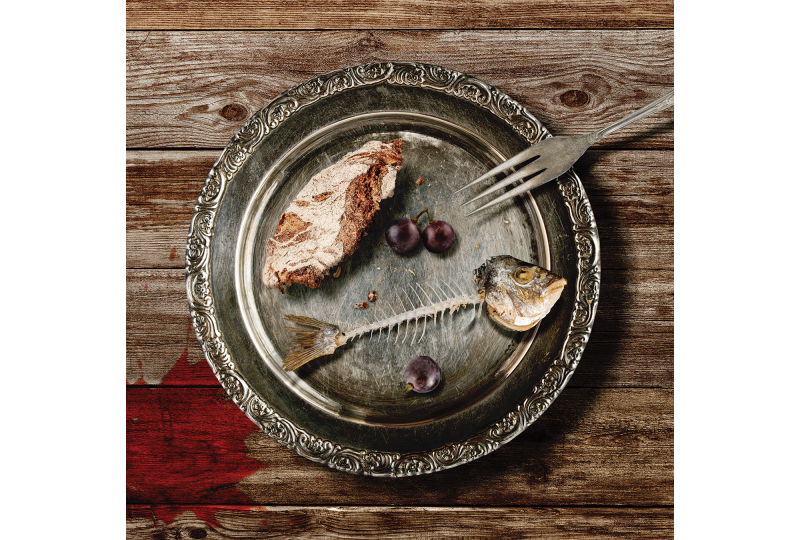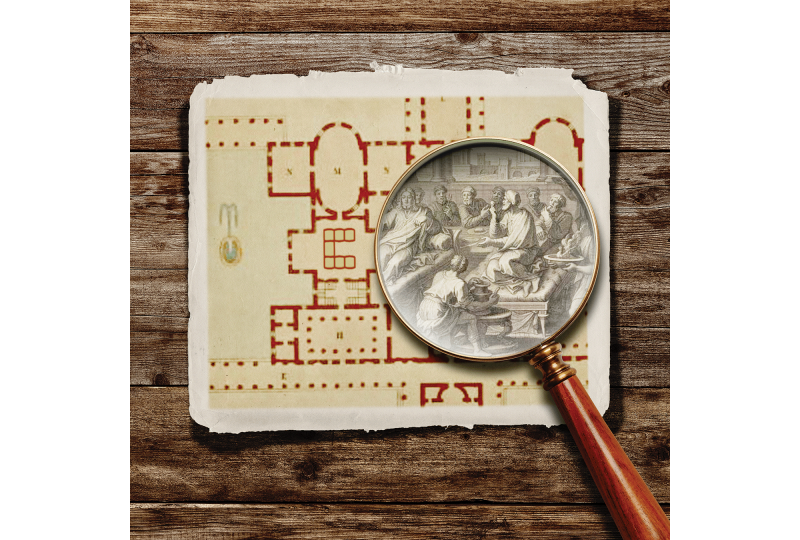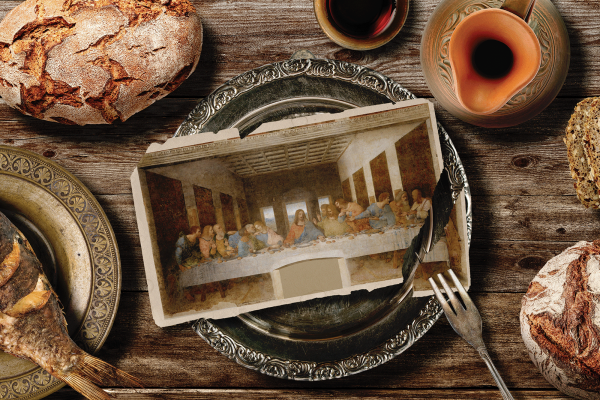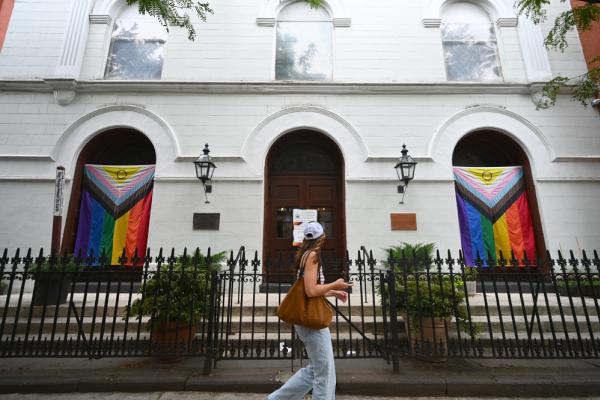While they were eating, Jesus took a loaf of bread, and after blessing it, he broke it, gave it to the disciples, and said, “Take, eat; this is my body.” Then he took a cup, and after giving thanks, he gave it to them, saying, “Drink from it, all of you; for this is my blood of the covenant, which is poured out for many for the forgiveness of sins.”
— Matthew 26:26-28
CLIMBING ROCK HILLSIDES and wading across gurgling streams lined with thistles, a friend and I walked the Jesus Trail in Galilee a few years ago. After about 8 miles of vigorous hiking each day, the trail led to a hostel or home with a hot meal we shared with other travelers. Our common identification with Jesus on this journey from Nazareth to Capernaum made these bread-breaking events seem to us almost like a “Lord’s Supper”! We were strangers from different countries, but our hunger and our common passion for walking where Jesus walked drew us together.
If eating together helps create a bond between diverse people, what compelled the Apostle Paul to write these words to his house churches in the city of Corinth: “Now in the following instructions I do not commend you, because when you come together, it is not for the better but for the worse.” (1 Corinthians 11:17)?
How does eating a bread cube and drinking a swallow of juice with other church members make things worse in the congregation? What divisions are keeping people apart from each other? Let’s dig into the context.
The Apostle Paul came to Corinth around 49 CE, on his second missionary trip. After he had founded several house churches in various parts of this busy, cosmopolitan trading center, he left Corinth to preach in the city of Ephesus in Asia Minor.
However, Paul may have left prematurely. After some time, several men from Corinth sailed east across the Aegean Sea to visit him and to ask for help with various problems that had developed in the churches (1 Corinthians 16:15-18). Abuses occurring at their common meal was only one of many troubling issues. Focusing on these meals associated with their worship may give us insight into other concerns Paul had with his infant house churches in Corinth.
Are you hungry — or drunk?
IT IS NATURAL to read into the text our own experiences of sharing communion. Thus, when Paul describes the Corinthian believers’ behavior in verses 20-21 — where some leave the meeting hungry, and others are drunk — we are appalled. We’d never act like that at an ordinary church potluck, let alone at our sacred communal commemoration of Jesus’ death! Are these rude, uneducated people who have no concern for each other?
But Paul does not give up on his house churches. After a hearty scolding, he reminds them of the reason they began eating together in the first place. Verses 23-26 describe Jesus’ last meal before he was arrested and executed. Written a few decades later, Matthew, Mark, and Luke all record this powerful, symbolic event. “Do this,” Jesus says, as often as you eat bread and drink wine together. In other words, share this bread and wine with each other.
According to Paul, these new believers do not yet understand that meeting together makes them a part of the body of Jesus. Without that understanding, they “eat and drink judgment against themselves. “That’s why many of you are weak and ill,” says Paul, “and some have died” (11:29-30). It’s not just spiritual oneness. It implies being responsible for every believer in your “body” — your house church — so that everyone has enough to eat!
plate_with_bones.png

The cost of “body” discipleship
AS PAUL PROCLAIMS the good news about Jesus, he struggles with the rigidity of social class in Greco-Roman urban culture. It is even more pronounced in a raunchy, international city such as Corinth. Yes, this city had both rich and poor people, just as we do today in Western culture.
But our way of life is vastly different. Today, we have the space, transportation, and many other technologies that allow people of different classes and races to live separate lives even in the same community. Low-income people live (and rent) in low-income neighborhoods, while middle-class people experience a much wider range of options. They socialize with people of their own class and attend events or belong to churches and social groups that share their values and level of education. If you are reading this article and can afford a subscription to Sojourners, you are probably somewhere in the broad middle class of the Western world.
But the ancient Greco-Roman culture in which Paul lived and preached had none of our essential technology — automobiles, electricity, cell phones, indoor plumbing, supermarkets, and so many other conveniences. Instead, the ruling classes were heavily dependent on people socially beneath them to do their “scut-work” of all kinds.
Roughly a third to a quarter of the population were slaves forced into servitude through poverty or as captives of war. Slaves had no rights, not even to their own bodies. Poor free or freed people worked from dawn to dusk to survive, feed their children, and rent tiny, bare, upper-story tenement rooms.
Barely 10 percent of the population could be considered upper-class. These families held onto their wealth through inheritance, arranged marriages, and professional connections. From their perspective, people in lower classes existed for their benefit. Although this arrangement meant that all kinds of people rubbed shoulders with each other, class rigidity was necessary to keep them “in their place” at all times.
This was the stratified world in which Paul, an educated Jewish man, preached a message of radical equality between Jew and Gentile, slave and free, male and female (Galatians 3:28). His Damascus road vision of Jesus as God’s incarnate son sent for all humanity changed everything for him.
Paul and his co-workers preached in many cities of the Greco-Roman world — first in Jewish synagogues and then to anyone who would listen. Often synagogues would attract a few Gentile God-worshippers as well. Paul’s method of bringing about this new age of oneness through Jesus was to establish small groups of believers within walking distance of each other. After a day’s work, they could meet regularly to eat, study, and worship together. Thus, they would demonstrate their calling as unified Jews and Greeks, rich and poor, slaves and freepersons “proclaiming the power and wisdom of God” through the crucified Christ (1 Corinthians 1:24-26). They would put into practice Jesus’ vision of equality.
That, at least, was the vision. Living it out was another story.
Know your place and be content
THE RIGID SOCIOECONOMIC divisions in 1 Corinthians 11:18 are further complicated by differing religious and political perspectives among Jews and formerly pagan Greco-Romans. Just after Paul’s greetings and thanksgiving for all the believers in 1 Corinthians 1:1-9, he refers to divisions within at least one of the house churches he had established (verses 10 to 17). “Chloe’s people” reported to him that four factions within her house church each identify with a different Christian leader.
Apollos is a Christian preacher from North Africa, probably well-educated and attracting wealthier Corinthians. “Those of Paul” are likely his converts from lower classes who support social equality. “Those of Cephas” (Peter) are Jews with distinctive meal practices that lead to criticism of others. And “those of Christ” are likely slaves with no human patron but who draw their sense of worth from the shamefully crucified Jesus.
So where can such a diverse group eat and worship together? The only people whose homes were large enough to host groups of 10 or more persons were from the upper classes. But that’s also where the local Jesus-groups run into social class rigidity. “When the time comes to eat the Lord’s Supper, each of you goes ahead with your own suppers, and one goes hungry, and another becomes drunk” (11:21).
Visitors entered a wealthy, freestanding villa of that time through the atrium, or roofed porch. If the male owner invited friends for a meal, they went inside to eat in the triclinium (dining room), named for the table with couches on three sides found there. If a wife came along, she would sit on the couch beside her husband.
finger_spot.png

Wealthy men were able to stop work in the late afternoon and enjoy a relaxed evening together. First, they thanked the god or goddess in whose name they were meeting. After the food was eaten, another blessing was prayed over the cup, followed by the ritual of mixing the drinks.
Although eating together created a special bond among the diners, even within the same group people sat or reclined according to their rank. Those of higher status received food of higher quality. In the Roman mind, this made perfect sense. It contributed to the stability of the empire by reminding all people they should know their place and be content within it.
Challenging the status quo
BUT NOW PAUL’S house-church vision upsets the routine. Lower-class tradespeople and slaves had to work until sunset, so by the time they arrived in the atrium, the meal in the dining room would be over (verse 21). Perhaps a few loaves were passed to those in the atrium, after which the house church would gather there for worship. Paul wants everyone to wait until all are present so they can eat together as a house church (verse 33).
Unfortunately, most translations of 11:34 give a wrong impression to modern middle-class readers. Both the NRSV and CEB say, “If you are hungry, eat at home.” This suggests that believers in first-century Corinth had homes with kitchens like ours, and that the Lord’s Supper was only symbolic. But the Greek word translated “at home” is oikia, which literally means “house.” Paul wants the believers to eat in the house where they are meeting as a house church!
You do not tell slaves or other low-income people to “eat at home”! Slaves have no home and pick up food where they find it while at work. Poor persons — free or freed — have no place to store food in tiny tenement rooms or if they are homeless. (This may also be a time of famine; see 8:26, where Paul speaks of “this present crisis.”)
To Paul, the purpose of a house church is that everyone brings what food they can and shares it with others. In this way, all can be fed both spiritually and physically. Because of his encounter with Jesus and Jesus’ followers, Paul has a radical, equalizing theology that is a threat to anyone with social privileges in that culture.
No doubt he is telling the truth in 1:26-31 when he writes, “Brothers and sisters, not many of you were wise by human standards, or powerful, or of noble birth.” The cost of discipleship was probably too high for most higher-class Corinthians.
What then shall we do?
WAS PAUL’S VISION of an egalitarian community realistic in his hierarchical Greco-Roman world? He must have learned much from the early Christian communities in Jerusalem and Antioch. According to Acts 4:32-36 and 6:1-7, believers shared “all things in common.” This practice of eating meals together and pooling resources continued. We read an example of this in the story of Tabitha and a group of widows (Acts 8:36-43).
Many of us share a concern for low-income people around us and in many parts of the world. We probably also “take communion” in our respective churches from time to time. But does a bread cube and sip of grape juice remind us of local low-income people who lack sufficient food? Instead, we take literally the mistranslation, “if you’re hungry, eat at home.”
Should not our communion services be a time to connect our sharing in Jesus’ body and blood with contemplating how we might share food, justice, and community with people in need of them? Christ’s body given for us is sign and symbol of the body of believers — from all economic statuses — in our communities. That’s the vision Paul lays out, and a central aspect of the gospel.

Got something to say about what you're reading? We value your feedback!






